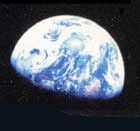|
Living things
The global extinction of species now going on is more rapid than
any of the great extinctions in the geological record not caused
by cosmic collisions.
That this is so
was made clear in a major study, Global Biodiversity Outlookש,
in May 2010. It was revised to a lower but still alarming rate by
another study reported in the journal Nature in May 2011.
The declines in
species are caused mainly by loss of habitat; and this is due to
human encroachment, also to melting ice, rising sea, and other changes
brought by global warming.
Among the species
threatened with extinction are emperor penguins, loggerhead turtles,
ringed seals, salmon, clownfish, Arctic foxes, and staghorn coral.
A few other examples:
Whales, as we all
know, were being driven toward extinction by hunting, still continued
by Iceland, Norway, and Japan. But more whales than ever died from
hunting are now dying from other human-caused effects. They are
hit by ships, entangled in fishing gear, or disoriented by military
sonar (now found to be much louder than had been thought). Changing
water temperature, and the acidifying of the ocean, forces them
to travel farther in search of food.
Twenty percent of
lizard species are now considered endangered. Many lizards live
in climates so hot that they must get out of the sun in the middle
of the day before it overheats them. With even higher temperatures,
the time when they can forage for food grows shorter.
Walruses have to
migrate annually from the southern coast of Alaska through the Bering
Strait to the northern coast of Siberia. They weigh up to two tons
and are not built for long-distance swimming, so they swim effortfully
with their heads raised, as if breast-stroking. They depend on ice
floes on which to take rests and from which to dive for the bottom-dwelling
shellfish which are their food. With rising temperature the floes
have become fewer and thinner.
Birds are sensitive
indicators of climate change, because their populations move about,
so it can be very noticeable when suddenly a region has far more
or fewer of them. It was estimated (by a 2010 conference of 200
experts on bird migration) that over the past decades 20 billion
birds have changed their migration habits. The overwhelming explanation
is climate change. Miguel Ferrer of Spain's Higher Council for Scientific
Research said: “That has a knock-on effect on almost everything
they do, from breeding habits to feeding habits to their genetic
diversity, which in turn affects other organisms in their food chain.
It's a huge behavioural change, forced on them by rising temperatures.”
The last comparable phenomenon that forced such a wave of adaptation
on birds was the Ice Age. But the present change is much faster
and the adaptation may be much less successful, because available
habitats are now so broken up by human use.
Sir Geoffrey Chandler,
business leader and human-rights activist, who died in 2011, wrote
to me in 2009: “It is clear to me, as someone who has observed
butterflies from his youth, that the population changes I have witnessed
and am witnessing are irreversible indicators of climate change.
Not as visible and dramatic as the shrinking of the glaciers and
ice-sheets, but nonetheless a canary in the mine . . .
History will not forgive the saboteurs and the business interests
which have financed the sceptics and continue to argue against the
science.“
return
|

